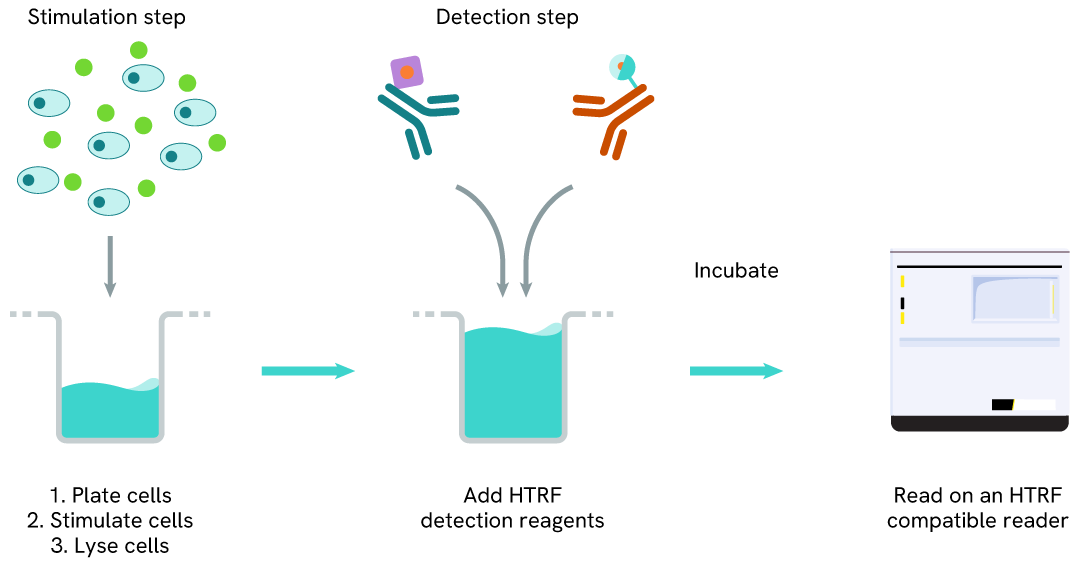

HTRF Total MSH3 Detection Kit, 500 Assay Points

HTRF Total MSH3 Detection Kit, 500 Assay Points




This HTRF kit enables the cell-based quantitative detection of MSH3 as a readout for DNA mismatch repairs in DNA replication.
For research use only. Not for use in diagnostic procedures. All products to be used in accordance with applicable laws and regulations including without limitation, consumption and disposal requirements under European REACH regulations (EC 1907/2006).
| Feature | Specification |
|---|---|
| Application | Cell Signaling |
| Sample Volume | 16 µL |
This HTRF kit enables the cell-based quantitative detection of MSH3 as a readout for DNA mismatch repairs in DNA replication.
For research use only. Not for use in diagnostic procedures. All products to be used in accordance with applicable laws and regulations including without limitation, consumption and disposal requirements under European REACH regulations (EC 1907/2006).


HTRF Total MSH3 Detection Kit, 500 Assay Points


HTRF Total MSH3 Detection Kit, 500 Assay Points


Product information
Overview
MSH3, also known as MutS Homolog 3, is a protein that plays a key role in DNA mismatch repair (MMR), a mechanism that ensures the fidelity of DNA replication and maintains genomic stability over time. The MSH3 protein fulfills its function as part of a MutS heterodimeric complex which includes another MutS homolog, typically MSH2.
Specifications
| Application |
Cell Signaling
|
|---|---|
| Brand |
HTRF
|
| Detection Modality |
HTRF
|
| Molecular Modification |
Total
|
| Product Group |
Kit
|
| Sample Volume |
16 µL
|
| Shipping Conditions |
Shipped in Dry Ice
|
| Target Class |
Phosphoproteins
|
| Technology |
TR-FRET
|
| Unit Size |
500 Assay Points
|
How it works
HTRF Human Total MSH3 assay principle
The MSH3 assay measures MSH3 in cells. Unlike Western Blot, the assay is entirely plate-based and does not require gels, electrophoresis, or transfer. The assay uses 2 antibodies, one labeled with a donor fluorophore and the other with an acceptor. MSH3 binding by the antibodies enables an immune-complex formation which brings the donor fluorophore into close proximity to the acceptor, thereby generating a FRET signal. Its intensity is directly proportional to the concentration of MSH3 protein present in the sample, and provides a means of assessing the protein’s expression under a no-wash assay format.

HTRF Human Total MSH3 one-plate assay protocol
Detection of Total MSH3 with HTRF reagents can be performed in a single plate used for culturing, stimulation, and lysis. No washing steps are required. This HTS designed protocol enables miniaturization while maintaining robust HTRF quality.

HTRF Human Total MSH3 two-plate assay protocol
The two-plate protocol involves culturing cells in a 96-well plate before lysis, then transferring lysates to a 384-well low volume detection plate before the addition of Total MSH3 HTRF detection reagents. This protocol enables the cells' viability and confluence to be monitored.

Assay validation
Validation of HTRF MSH3 Total Detection Kit with siRNA-treated cells
HEK293T cells were plated at different cell densities under 50 µl in a 96-well plate in complete culture medium, and incubated overnight at 37°C, 5% CO2. After incubation, cells were siRNA treated by adding 50 µl of a mix of Transfection Reagent (Santa Cruz# sc-29528)/siRNA for MSH3. Cells were then incubated for 48h at 37°C, 5% CO2. For untreated cells, 50 µl of Transfection medium were added.
After incubation, cells were lysed with 50 µL of Lysis Buffer #2 at 1X for 30 minutes at RT under gentle shaking, and 16 µL of lysate were transferred into a low volume white microplate before the addition of 2 µL of the HTRF d2 detection reagent and 2 µL HTRF Eu-K detection reagent. The HTRF signals were recorded after 4H and ON incubations.

Simplified pathway
MSH3 roles in DNA repair
MutS heterodimeric complexes of MSH2/MSH3 move along DNA strands, where they act as sensors of mismatchesand non-homologous sequences. When such a mismatchhas been identified, the MutS complex stops on site and recruits an assortment of effectors, like MutL complexes (MLH1/PMS2) and endo/ exonucleases, which cut out the mismatched part of the sequence. This is followed by DNA polymerase and DNA ligase that fill in the missing bases and seal the strands back together.

Resources
Are you looking for resources, click on the resource type to explore further.
HTRF: unfamiliar territory?
This technical brochure reviews the general principles of HTRF™ and the associated Tag-lite™ technology...
Discover the versatility and precision of Homogeneous Time-Resolved Fluorescence (HTRF) technology. Our HTRF portfolio offers a...
This document includes detailed tables listing HTRF™, AlphaLISA™ SureFire® Ultra™, and Alpha SureFire® Ultra™ Multiplex assays...
Your guide for improving cell signaling assay performance
This complete Revvity guide provides you with all the tools you need to...


How can we help you?
We are here to answer your questions.






























